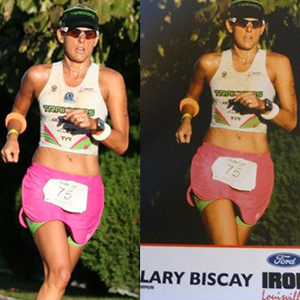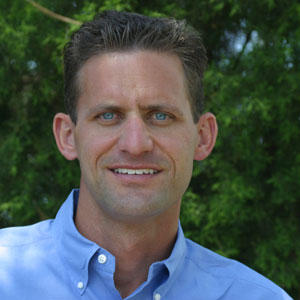Hillary Biscay, Digitally Remastered

World Triathlon Corporation is the most important brand in the sport of triathlon. While it is not my client, it is a proximate cause of much of my income. This, because its strength, ambition and execution build the sport of triathlon like no other brand worldwide can, the Olympic rings inclusive.
So I stick my nose into its business like a Wall Street analyst, or a financial reporter trying parse the meaning of the Fed chairman's choice of one preposition over another.
The microscope I use may be a tad strong at times.
So you'll understand if I and a few of my Slowtwitch Reader Forum buddies got a bit worked up last night over a picture of pro athlete Hillary Biscay that had been digitally altered for a promotional piece generated by WTC. Her race outfit bore one less sponsor than it actually bears in real life.
This is not an isolated practice. Whenever I see a television ad featuring cyclists, I'm shocked if the bicycles in the ad still have decals on their down tubes.
But there's a difference between bicycles purchased by a production company and ridden by nondescript weekenders for the purpose of a commercial, versus a company interposing itself between a pro athlete and his or her sponsor, the two of which are bound together in a personal services bond, usually secured by a contract.
The legality of the practice of airbrushing is not my concern. Rather, the problem is the economics of long distance triathlon. Unlike short distance racing, you can't race often enough to live off prize money, and the prize money's not that big anyway. You aren't going to get federation money. You make your money from your sponsors. When that athlete-sponsor relationship is hidden from public view based on the whim of a person with a copy of Adobe Photoshop, it becomes cynical to say, "Make your money off your sponsors," and then fiddle with that revenue stream as well.
Since the Ironman World Championship last year, WTC's rules and behavior for media has also been changing. It now governs and controls much more of the imaging at its events. This places a further burden on WTC for those images, and the use of those images, to reflect honestly and transparently what occurs at its races.
As it turns out, I'm not the only one who feels this way. So does Jessica Weidensall, WTC's Director of Global Public Relations. Neither of us is under any illusion. Altering images is a common industry practice.
"We do not feel that we should be promoting competing race series," said Weidensall. "They certainly are not promoting our races."
Weidensall maintains an Ironman logo was removed from an ad that appeared in Triathlete Magazine. So, in a sense, sauce for the goose is sauce for the gander. Why shouldn't we expect WTC to fall in line with common practice?
Ms. Weidensall is not insensitive to the fact that her company's athletes are primarily dependent on income from sponsors. When kits are altered, when wheel and helmet stickers, and down tube decals, disappear from promotional materials, it discourages the rest of the industry from investing in the sport. It isolates WTC from its industry, rather than knitting it in.
WTC is taking an attentive look at a practice that Ms. Weidensall acknowledges can be avoided for the most part. This, even though WTC can occasionally be the target of the same behavior.
"In the past, our policy has been to choose the best image, the most incredible athlete shot or the photo that best showcases an event, and make it work for the collateral," she said. "Moving forward we will do our best to limit selection to images we're comfortable using in their original states."
"We are protective of our brands and partners," said Weidensall and by partners she refers to Ironman sponsors and licensees. "But the athletes are our partners too. Our ambitions do not blind us to the needs of those in our industry, our athletes and their sponsors inclusive."
As WTC undertakes its responsibility for world leadership in triathlon—a posture I've noticed it striking over the last couple of years—its practices will be dictated by its own sense of ethics, rather than conformity to industry standards. It will take time for all 150 employees in the building to get that memo.
I'll adjust my microscope accordingly, to allow for that transition.
As an aside, may we be the first to deliver, for the use of his well-traveled photo, a credit to the photographer? Thank you Slowtwitcher Jaime Vigaray 😉



